【满分攻略】 专题十三 一般现在时(课件)-小升初英语复习精讲精练(全国通用版)(共43张PPT)
文档属性
| 名称 | 【满分攻略】 专题十三 一般现在时(课件)-小升初英语复习精讲精练(全国通用版)(共43张PPT) |  | |
| 格式 | pptx | ||
| 文件大小 | 5.7MB | ||
| 资源类型 | 试卷 | ||
| 版本资源 | 通用版 | ||
| 科目 | 英语 | ||
| 更新时间 | 2025-05-27 14:09:24 | ||
图片预览

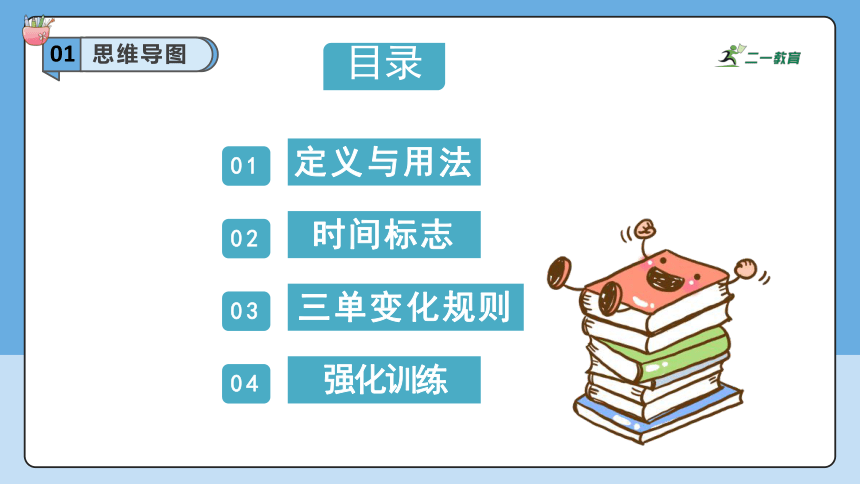
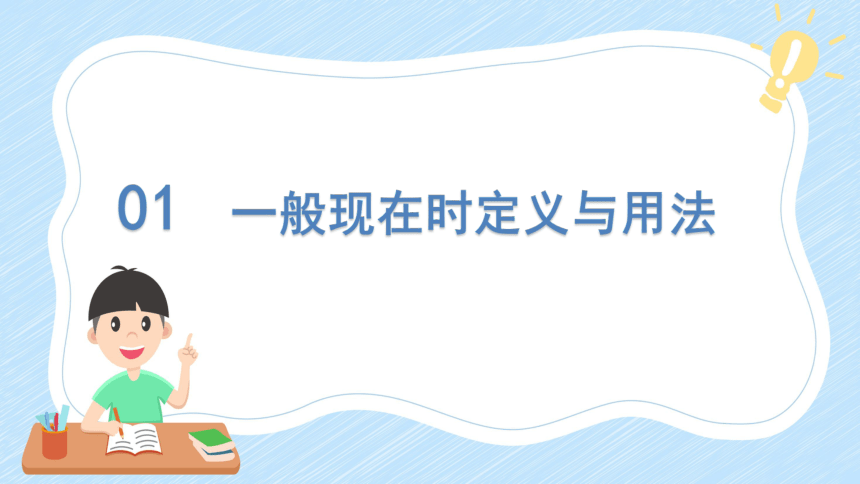
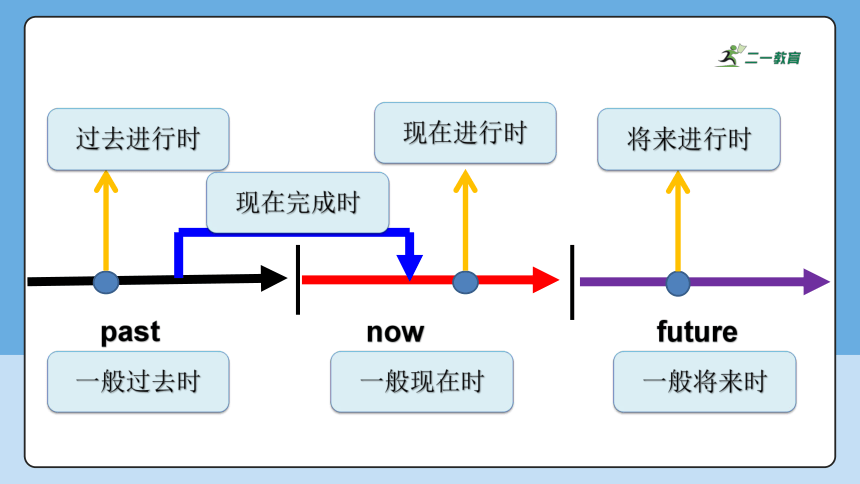


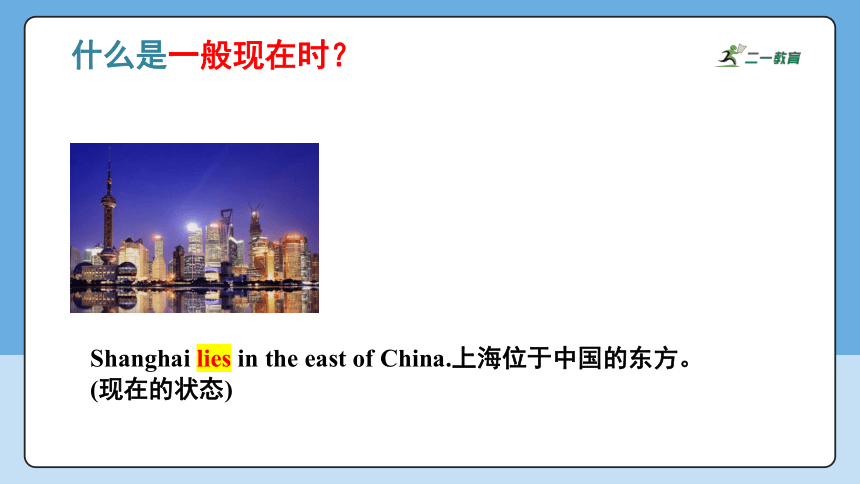

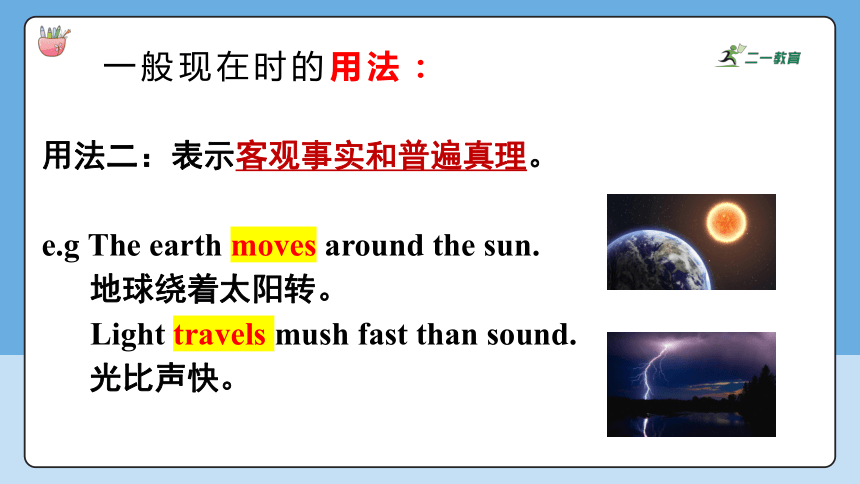

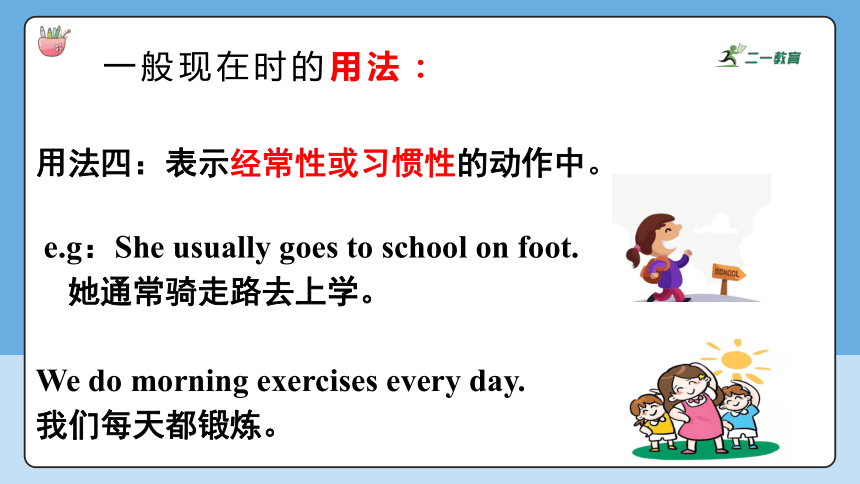

文档简介
(共40张PPT)
小升初英语知识点梳理
专题十三 一般现在时
01
思维导图
定义与用法
01
时间标志
02
三单变化规则
03
强化训练
04
目录
01 一般现在时定义与用法
past
now
future
过去进行时
现在进行时
将来进行时
现在完成时
一般过去时
一般现在时
一般将来时
什么是一般现在时?
一般现在时是英语中最基本的时态之一,通常用于表达:
He does exercises every day.他每天锻炼(日常行为)
什么是一般现在时?
The sun rises above the horizon.太阳升起在地平线上。
(普遍真理)
什么是一般现在时?
Shanghai lies in the east of China.上海位于中国的东方。
(现在的状态)
一般现在时的用法:
用法一:表示现在的状态、特征、能力、性格等
She has long hair.她有长头发。
用法二:表示客观事实和普遍真理。
e.g The earth moves around the sun.
地球绕着太阳转。
Light travels mush fast than sound.
光比声快。
一般现在时的用法:
用法三:表示格言或警句中。
e.g Pride goes before a fall. 骄者必败。
Practice makes perfect. 熟能生巧。
一般现在时的用法:
用法四:表示经常性或习惯性的动作中。
e.g:She usually goes to school on foot.
她通常骑走路去上学。
We do morning exercises every day.
我们每天都锻炼。
一般现在时的用法:
用法一:表示现在的状态、特征、能力、性格等
用法二:表示客观事实和普遍真理。
用法三:表示格言或警句中。
用法四:表示经常性或习惯性的动作中。
Summary
02 时间标志
一般现在时的标志词:①频率副词
Minions are always happy. 小黄人们总是很开心。
频率副词的频率由大到小排列
always usually often sometimes never
含义 总是 通常 经常 有时 从不
频率 100% 80% 60% 40% 0%
一般现在时的标志词:②every系列
Lily feels happy every day. 每天都很开心。
一般现在时的标志词:③其它
Daming plays football on the weekend. 大明在周末踢足球。
Exercise:下列的句子哪些是一般现在时?
1.I go to school at 7 every morning.
2.Xiao Wang is doing homework now.
3.Lily is going to Beijing next week.
4.She had a cold last night.
5.Zhang peng likes English.
√
√
×
×
×
03 一般现在时的结构
一般现在时的结构:①含有be动词
1. 谓语是be(am/is/are)的一般现在时。
①肯定形式:主语+be+表语(形容词、名词充当表语)
I am a teacher. 我是老师。
You are friendly.你很友好。
He is 13 years old.他13岁。
②否定形式:主语+be+not+表语(形容词、名词充当表语)
I am not a teacher. 我是老师。
You are not friendly.你很友好。
He is not 13 years old.他13岁。
1.Be 的用法:
I用 am, you用are,
is用于他(he)、她(she) 、它(it),
复数(we,you,they)全部都用 are.
一般现在时的结构:①含有be动词
一般疑问句:Be+主语+表语(形容词、名词充当表语)
She is a student.
Is she student
—Yes, she is.
—No,she isn’t.
特殊疑问句形式:特殊疑问词+Be开头的一般疑问句
She is from China.(对画线部分提问)
—Where is she from?
肯定回答:Yes,主语+be.
否定回答:No, 主语+ be+not.
一般现在时的结构:②谓语动词是实义动词。
①肯定形式:
“主语+及物动词+宾语”或“主语+不及物动词”。
I teach English. .我教英语。
Miss White teaches English.怀特老师教英语。。
②否定形式:
“主语+don't/doesn't+及物动词+宾语”
或“主语+don't/doesn't+不及物动词”。
I don't teach English.我不教英语。
She doesn't teach English.怀特老师不教英语。
主语:第一/二人称、第三人称复数 谓语动词:do
主语:第三人称单数
谓语动词:does
③一般疑问句形式:
“Do/Does+主语+及物动词原形+宾语”
或“Do/Does+主语+不及物动词原形”。
肯定回答:Yes,主语+do/does.
否定回答:No, 主语+ don't/doesn't.
—Do you eat every morning
—Yes, I do./No, I don't.
—Does she have a little brother
—Yes, she does./No, she doesn't.
④特殊疑问句:
特殊疑问词+do/does开头的一般疑问句?
What do you like
When do you go to school
注意:根据主语确定用do还是does。
3. 谓语是情态动词can/may...+动词原形的一般现在时。
①肯定形式:主语+情态动词can/may.....+动词原形+宾语。
I can swim in the sea. 我可以在海里游泳。
②否定形式:主语+情态动词can/may.....+not+动词原形+宾语。
I can't swim in the sea.我不能在海里游泳。
③一般疑问句形式:
情态动词Can/May.....+主语+动词原形+主语+宾语。
肯定回答是:Yes,主语+情态动词.
否定回答是:No, 主语+ 情态动词+not.
Can you swim
-Yes, I can. / No, I can't.
④特殊疑问句形式:
特殊疑问词+情态动词can/may.....开头的一般疑问句?
—What can you do
—I can do my homework.
注意:情态动词can/may.....+动词原形。
03 动词变化
行为动词do一般现在时第三人称单数的构成规则:
动词三单变化规则
直接+s
work works
play plays
sing sings
以o、ch、sh、x结尾+s
go goes
watch watches
wash washes
辅音字母+y结尾,把y变i+es
study studies cry cries
不规则变化:have-has
1、动词原形变三单,一般的直接在动词原形后加_____.
2、以____、____、____、____、____结尾的动词,在后面加____。
3、以________结尾的动词,把____变____再加____。
4.特殊情况:____变成____
一起来回忆
s
o
sh
ch
x
s
es
辅音字母+y
y
i
es
have
has
① 找时间标志词,判断时态【一般现在时】
② 找主语,判断是否需要进行动词变化
解题方法
1. 填空、选择解题两步走
① 含有be 动词以及情态动词的句型转化
肯定句:主语+am/is/are/情态动词+其他.
She is beautiful./ She can sing.
否定句:主语+am/is/are/情态动词+not+其他.
She___________ beautiful./She ________ sing.
一般疑问句: Am/Is/Are/情态动词+主语+其他?
_____ she beautiful / ______ she sing
解题方法
2. 句型转换解题技巧
is not (isn’t)
can’t
Is
Can
解题方法:
1.肯定句改为否定句 :
在be动词或情态动词后+ not
2. 肯定句改为一般疑问句:
Be动词或情态动词 提前
② 含有实义动词的句型转化
肯定句:主语+动词原形或第三人称单数形式+其他.
She likes reading.
否定句:主语+助动词do/does+not+动词原形+其他.
She ____________ _________ reading.like
一般疑问句:助动词Do/Does+主语+动词原形+其他
________ she _______ reading
解题方法
2. 句型转换解题技巧
does not (doesn’t)
like
Does
like
解题方法:
1.肯定句改为否定句 :
在实义动词之前加助动词do/does +not;
实义动词改为原形
2. 肯定句改为一般疑问句:
句首加助动词do/does ;
实义动词改为原形
请记住句型转换注意事项:
当句中没有be动词或情态动词时,
在主语前加助动词do/does变一般疑问句;
在主语后谓语动词前加助动词don't/doesn't
变否定句,助动词后的动词要变为动词原形。
解题方法
2. 句型转换解题技巧
04 强化训练
03
强化训练
一、写出所给词的第三人称单数形式
sit swim read make run
write have go do watch
cry study play say wash
sits
swims
reads
makes
runs
writes
has
goes
does
watches
cries
studies
plays
says
washes
二.根据所给词的适当形式填空。
1.Tom often_____( get ) up at six in the morning
2. The earth ______ ( go) around the sun .
3.Mary’s parent ______(live ) in Beijing .
4. She _______ (draw) very well.
5. ______ they _________ (like) the World Cup
6. What they often_________ (do) on Saturdays
7. ______ your parents _________ (read) newspapers every day
gets
goes
lives
draws
Do like
do
Do read
三、单项选择
( ) 1. The earth around the sun.
A. move B. moves C. moving
( )2. Enough enough.
A. am B. is C. are
( )3. Where John live
A. does B. is C. do
( ) 4. When your birthday
A. am B. are C. is
( ) 5. Jimmy vegetables but he fruit.
A. like; like B. likes; likes C. likes; doesn't like
四、句型转换
1. I go to school by bus. (用He做主语变否定句)
________________________________________
2. Kim plays baseball very well. (变一般疑问句)
________________________________________
3. David doesn’t like learning French. (变肯定句)
________________________________________
4. Alan doesn’t watch TV on school nights. (变肯定句)
________________________________________
Does he go to school by bus
Does Kim plays baseball very well
David likes learning French.
Alan watches TV on school nights.
Thanks!
https://www.21cnjy.com/recruitment/home/fine
小升初英语知识点梳理
专题十三 一般现在时
01
思维导图
定义与用法
01
时间标志
02
三单变化规则
03
强化训练
04
目录
01 一般现在时定义与用法
past
now
future
过去进行时
现在进行时
将来进行时
现在完成时
一般过去时
一般现在时
一般将来时
什么是一般现在时?
一般现在时是英语中最基本的时态之一,通常用于表达:
He does exercises every day.他每天锻炼(日常行为)
什么是一般现在时?
The sun rises above the horizon.太阳升起在地平线上。
(普遍真理)
什么是一般现在时?
Shanghai lies in the east of China.上海位于中国的东方。
(现在的状态)
一般现在时的用法:
用法一:表示现在的状态、特征、能力、性格等
She has long hair.她有长头发。
用法二:表示客观事实和普遍真理。
e.g The earth moves around the sun.
地球绕着太阳转。
Light travels mush fast than sound.
光比声快。
一般现在时的用法:
用法三:表示格言或警句中。
e.g Pride goes before a fall. 骄者必败。
Practice makes perfect. 熟能生巧。
一般现在时的用法:
用法四:表示经常性或习惯性的动作中。
e.g:She usually goes to school on foot.
她通常骑走路去上学。
We do morning exercises every day.
我们每天都锻炼。
一般现在时的用法:
用法一:表示现在的状态、特征、能力、性格等
用法二:表示客观事实和普遍真理。
用法三:表示格言或警句中。
用法四:表示经常性或习惯性的动作中。
Summary
02 时间标志
一般现在时的标志词:①频率副词
Minions are always happy. 小黄人们总是很开心。
频率副词的频率由大到小排列
always usually often sometimes never
含义 总是 通常 经常 有时 从不
频率 100% 80% 60% 40% 0%
一般现在时的标志词:②every系列
Lily feels happy every day. 每天都很开心。
一般现在时的标志词:③其它
Daming plays football on the weekend. 大明在周末踢足球。
Exercise:下列的句子哪些是一般现在时?
1.I go to school at 7 every morning.
2.Xiao Wang is doing homework now.
3.Lily is going to Beijing next week.
4.She had a cold last night.
5.Zhang peng likes English.
√
√
×
×
×
03 一般现在时的结构
一般现在时的结构:①含有be动词
1. 谓语是be(am/is/are)的一般现在时。
①肯定形式:主语+be+表语(形容词、名词充当表语)
I am a teacher. 我是老师。
You are friendly.你很友好。
He is 13 years old.他13岁。
②否定形式:主语+be+not+表语(形容词、名词充当表语)
I am not a teacher. 我是老师。
You are not friendly.你很友好。
He is not 13 years old.他13岁。
1.Be 的用法:
I用 am, you用are,
is用于他(he)、她(she) 、它(it),
复数(we,you,they)全部都用 are.
一般现在时的结构:①含有be动词
一般疑问句:Be+主语+表语(形容词、名词充当表语)
She is a student.
Is she student
—Yes, she is.
—No,she isn’t.
特殊疑问句形式:特殊疑问词+Be开头的一般疑问句
She is from China.(对画线部分提问)
—Where is she from?
肯定回答:Yes,主语+be.
否定回答:No, 主语+ be+not.
一般现在时的结构:②谓语动词是实义动词。
①肯定形式:
“主语+及物动词+宾语”或“主语+不及物动词”。
I teach English. .我教英语。
Miss White teaches English.怀特老师教英语。。
②否定形式:
“主语+don't/doesn't+及物动词+宾语”
或“主语+don't/doesn't+不及物动词”。
I don't teach English.我不教英语。
She doesn't teach English.怀特老师不教英语。
主语:第一/二人称、第三人称复数 谓语动词:do
主语:第三人称单数
谓语动词:does
③一般疑问句形式:
“Do/Does+主语+及物动词原形+宾语”
或“Do/Does+主语+不及物动词原形”。
肯定回答:Yes,主语+do/does.
否定回答:No, 主语+ don't/doesn't.
—Do you eat every morning
—Yes, I do./No, I don't.
—Does she have a little brother
—Yes, she does./No, she doesn't.
④特殊疑问句:
特殊疑问词+do/does开头的一般疑问句?
What do you like
When do you go to school
注意:根据主语确定用do还是does。
3. 谓语是情态动词can/may...+动词原形的一般现在时。
①肯定形式:主语+情态动词can/may.....+动词原形+宾语。
I can swim in the sea. 我可以在海里游泳。
②否定形式:主语+情态动词can/may.....+not+动词原形+宾语。
I can't swim in the sea.我不能在海里游泳。
③一般疑问句形式:
情态动词Can/May.....+主语+动词原形+主语+宾语。
肯定回答是:Yes,主语+情态动词.
否定回答是:No, 主语+ 情态动词+not.
Can you swim
-Yes, I can. / No, I can't.
④特殊疑问句形式:
特殊疑问词+情态动词can/may.....开头的一般疑问句?
—What can you do
—I can do my homework.
注意:情态动词can/may.....+动词原形。
03 动词变化
行为动词do一般现在时第三人称单数的构成规则:
动词三单变化规则
直接+s
work works
play plays
sing sings
以o、ch、sh、x结尾+s
go goes
watch watches
wash washes
辅音字母+y结尾,把y变i+es
study studies cry cries
不规则变化:have-has
1、动词原形变三单,一般的直接在动词原形后加_____.
2、以____、____、____、____、____结尾的动词,在后面加____。
3、以________结尾的动词,把____变____再加____。
4.特殊情况:____变成____
一起来回忆
s
o
sh
ch
x
s
es
辅音字母+y
y
i
es
have
has
① 找时间标志词,判断时态【一般现在时】
② 找主语,判断是否需要进行动词变化
解题方法
1. 填空、选择解题两步走
① 含有be 动词以及情态动词的句型转化
肯定句:主语+am/is/are/情态动词+其他.
She is beautiful./ She can sing.
否定句:主语+am/is/are/情态动词+not+其他.
She___________ beautiful./She ________ sing.
一般疑问句: Am/Is/Are/情态动词+主语+其他?
_____ she beautiful / ______ she sing
解题方法
2. 句型转换解题技巧
is not (isn’t)
can’t
Is
Can
解题方法:
1.肯定句改为否定句 :
在be动词或情态动词后+ not
2. 肯定句改为一般疑问句:
Be动词或情态动词 提前
② 含有实义动词的句型转化
肯定句:主语+动词原形或第三人称单数形式+其他.
She likes reading.
否定句:主语+助动词do/does+not+动词原形+其他.
She ____________ _________ reading.like
一般疑问句:助动词Do/Does+主语+动词原形+其他
________ she _______ reading
解题方法
2. 句型转换解题技巧
does not (doesn’t)
like
Does
like
解题方法:
1.肯定句改为否定句 :
在实义动词之前加助动词do/does +not;
实义动词改为原形
2. 肯定句改为一般疑问句:
句首加助动词do/does ;
实义动词改为原形
请记住句型转换注意事项:
当句中没有be动词或情态动词时,
在主语前加助动词do/does变一般疑问句;
在主语后谓语动词前加助动词don't/doesn't
变否定句,助动词后的动词要变为动词原形。
解题方法
2. 句型转换解题技巧
04 强化训练
03
强化训练
一、写出所给词的第三人称单数形式
sit swim read make run
write have go do watch
cry study play say wash
sits
swims
reads
makes
runs
writes
has
goes
does
watches
cries
studies
plays
says
washes
二.根据所给词的适当形式填空。
1.Tom often_____( get ) up at six in the morning
2. The earth ______ ( go) around the sun .
3.Mary’s parent ______(live ) in Beijing .
4. She _______ (draw) very well.
5. ______ they _________ (like) the World Cup
6. What they often_________ (do) on Saturdays
7. ______ your parents _________ (read) newspapers every day
gets
goes
lives
draws
Do like
do
Do read
三、单项选择
( ) 1. The earth around the sun.
A. move B. moves C. moving
( )2. Enough enough.
A. am B. is C. are
( )3. Where John live
A. does B. is C. do
( ) 4. When your birthday
A. am B. are C. is
( ) 5. Jimmy vegetables but he fruit.
A. like; like B. likes; likes C. likes; doesn't like
四、句型转换
1. I go to school by bus. (用He做主语变否定句)
________________________________________
2. Kim plays baseball very well. (变一般疑问句)
________________________________________
3. David doesn’t like learning French. (变肯定句)
________________________________________
4. Alan doesn’t watch TV on school nights. (变肯定句)
________________________________________
Does he go to school by bus
Does Kim plays baseball very well
David likes learning French.
Alan watches TV on school nights.
Thanks!
https://www.21cnjy.com/recruitment/home/fine
